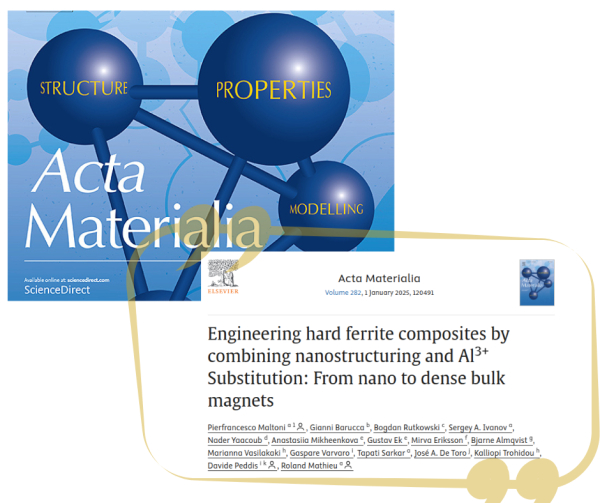This work has been developed in collaboration with the Group of Prof. Roland Mathieu at Uppsala University. The study systematically investigated the morphological, structural, and magnetic properties of Al-substituted SrFe₁₂O₁₉ and SrFe₁₂O₁₉/CoFe₂O₄ nanocomposites. Our results demonstrate that Al substitution in SFO significantly increases coercivity while preserving high saturation magnetization, offering an effective strategy for tuning magnetic properties without impurity phases. Furthermore, we explored two distinct synthesis routes for hard-soft nanocomposites: one based on preformed particles and the other on simultaneous co-synthesis of both phases. These approaches led to different cationic distributions and interface morphologies, revealing the critical role of synthetic control in optimizing super-exchange interactions. Monte Carlo simulations confirmed that enhancing interface exchange coupling improves remanent magnetization, aligning with experimental observations. Additionally, we investigated the impact of spark plasma sintering (SPS) on the magnetic properties of the nanocomposites. SPS compaction improved particle alignment and strengthened exchange coupling, leading to increased remanent magnetization while maintaining distinct hard-soft phase interactions. Notably, the presence of both phases hindered mutual grain growth, preserving their intrinsic magnetic properties during sintering.
Friday, 04 April 2025 10:12
Engineering hard ferrite composites by combining nanostructuring and Al³⁺ substitution: From nano to dense bulk magnets – A new Paper on Advancements in Permanent Magnets
The study focuses on the sol-gel synthesis of SrFe₁₂O₁₉/CoFe₂O₄ nanocomposites for high-coercivity permanent magnets using scalable methods.
The research investigates how morphology, structure, and composition influence magnetic properties: cation substitution and super-exchange coupling at the interface modulate hysteresis; Monte Carlo simulations confirm the key role of crystallite size and epitaxial growth; the Spark Plasma Sintering technique enhances magnetic performance by optimizing material design.
Article published in Acta Materialia.
Published in
Publications


 English (UK)
English (UK)  Italiano (Italia)
Italiano (Italia)